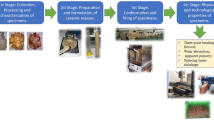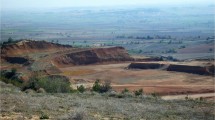The properties of ceramic are studied in the case where clay is modified by adding small amounts of glass fiber in the process of ultrasonic extrusion of laboratory samples. Ultrasound increases the strengthening action of the modifier. It consolidates the batch and orients its elongated particles along the direction of extrusion. After firing the modifier particles become hollow concretions-geodes which have a polycrystalline shell comprised of anorthite and are filled with needle-shaped crystals. The proposed method of extrusion increases the accuracy and informativeness of tests performed on modified clays.



Similar content being viewed by others
Notes
Here and below, content by weight, %, unless otherwise specified.
References
N. V. Boltakova, G. R. Faseeva, R. R. Kabirov, et al., “Utilization of inorganic industrial wastes in producing construction ceramics. Review of Russian experience for the years 2000 – 2015,” Waste Management, 60, 230 – 246 (2016); URL: doi.org/10.1016/j.wasman.2016.11.008.
P. Munoz, M. P. Morales, G. Viviana Letelier, and G. M. A. Mendívil, “Fired clay bricks made by adding wastes: assessment of the impact on physical, mechanical and thermal properties,” 125, 241 – 252 (2016); URL: doi.org/10.1016/j.conbuildmat. 2016.08.024.
V. Mymrin, R. A. C. Ribeiro, K. Alekseev, and E. Zelinskaya, “Environment friendly ceramics from hazardous industrial waste,” Ceram. Int., 40, 9427 – 9437 (2014); doi.org/10.1016/j.ceramint.2014.02.014.
P. Muñoz Velasco, M. P. Morales Ortíz, M. A. Mendívil Giró, et al., “Fired clay bricks manufactured by adding waste as sustainable construction material — a review,” Constr. Build. Mater., 63, 97 – 107 (2014); doi.org/10.1016/j.conbuildmat.2014.03.045.
C. Bories, M.-E. Borredon, E. Vedrenne, et al., “Development of eco-friendly porous fired clay bricks using pore-forming agents: a review,” J. Environ. Manage, 143, 186 – 196 (2014); doi: https://doi.org/10.1016/j.jenvman.2014.05.006
L. Zhang, “Production of bricks from waste materials — a review,” Constr. Build. Mater., 47, 643 – 655 (2013); doi.org/10.1016_j.conbuildmat.2013.05.043
G. R. Faseeva, R. M. Nafikov, S. E. Lapuk, et al., “Ultrasoundassisted extrusion of construction ceramic samples,” Ceram. Int., 43(9), 7202 – 7210 (2017); doi.org/10.1016/j.ceramint.2017.03.008.
R. R. Kabirov, L. N. Garipov, G. R. Faseeva, et al., “Prototy** of ultrasonic die for extrusion of ceramic brick,” Steklo Keram., No. 3, 85 – 90 (2017); R. R. Kabirov, L. N. Garipov, G. R. Faseeva, et al., “Prototy** of ultrasonic die for extrusion of ceramic brick,” Glass Ceram., 74(3 – 4), 85 – 90 (2017).
I. W. M. Brown and J. D. Mackenzie, “Process design for the production of a ceramic-like body from recycled waste glass. Part 1. The effect of fabrication variables on green strength,” J. Mater. Sci., 17(8), 2164 – 2170 (1982); doi.org/10.1007/BF00543724.
I. W. M. Brown and J. D. Mackenzie, “Process design for the production of a ceramic-like body from recycled waste glass. Part 2. The effect of fabrication variables on the physical properties of the fired body,” J. Mater. Sci., 17(8), 2171 – 2183 (1982); doi.org/10.1007/BF00543725.
I. W. M. Brown and J. D. Mackenzie, “Process design for the production of a ceramic-like body from recycled waste glass. Part 3. The influence of microstructure and devitrification behaviour on the physical properties,” J. Mater. Sci., 17(8), 2184 – 2193 (1982); doi.org/10.1007/BF00543726.
N. Phonphuak, S. Kanyakam, and P. Chindaprasirt, “Utilization of waste glass to enhance physical–mechanical properties of fired clay brick,” J. Cleaner Prod., 112, 3057 – 3062 (2016); doi.org/10.1016/j.jclepro.2015.10.084.
M. Dondi, G. Guarini, M. Raimondo, and C. Zanelli, “Recycling PC and TV waste glass in clay bricks and roof tiles,” Waste Manage, 29, 1945 – 1951 (2009). doi.org/10.1016/j.wasman. 2008.12.003.
G. R. Faseev, I. E. Mumdzhi, L. R. Gilyazov, et al., “Thermogravimetry and differential scanning calorimetry of the firing of full-length ceramic block,” Vest. Kazan. Tekhn. Univer., 20(3), 68 – 71 (2017).
GOST 7025–91. Bricks and Rock: Ceramic and Silicate. Methods of Determining the Water Absorption, Density, and Monitoring Frost Resistance [in Russian], Izd-vo Standartov, Moscow (1991); replaces GOST 7025–78; effective July 1, 1991.
GOST 8462–85.Wallings. Methods of Determining the Ultimate Bending and Compressive Strength [in Russian], Izd-vo Standartov, Moscow (1987); replaces GOST 8462–77; effective July 1, 1985.
Atlas of Concretions, Proc. VSEGEI [in Russian], New Ser., Nedra, Leningrad (1988), Vol. 340.
A. M. Salakhov, G. D. Ashmarin, V. P. Morozov, and R. A. Salakhova, “Ceramic materials from low-melting clays modified by industrial wastes from a glass-fiber plant,” Steklo Keram., No. 3, 3 – 7 (2014); A. M. Salakhov, G. D. Ashmarin, V. P. Morozov, and R. A. Salakhova, “Ceramic materials from low-melting clays modified by industrial wastes from a glass-fiber plant,” Glass Ceram., 71(3 – 4), 77 – 80 (2014).
L. A. Bashaeva and I. A. Bashaeva, Method of Obtaining Wollastonite, RF Patent 2091304, IPC C01B33/24; 96101391/25 [in Russian]; application January 23, 1996; published September 27, 1997.
A. V. Chichagov and Z. V. Shilova, “Information and computational system for crystalline data on minerals (Mincryst),” Kristallografiya, 35(3), 610 – 616 (1990).
We are grateful to Professor L. R. Tagirov and Reader A. M. Salakhov (Institute of Physics at Kazan Federal University) for organizational and material-technical assistance, as well as our colleagues at Ultrasonic Engineering – INLAB JSC for helpful consultations.
This work was supported by the Ministry of Education and Science of the Russian Federation (contract No. 02.G25.31.0121, 2014).
Author information
Authors and Affiliations
Corresponding author
Additional information
Translated from Steklo i Keramika, No. 12, pp. 31 – 37, December, 2017.
Rights and permissions
About this article
Cite this article
Faseeva, G.R., Nafikov, R.M., Lapuk, S.E. et al. Clay Modifier Activation for Ceramic Brick by Ultrasonic Extrusion. Glass Ceram 74, 450–455 (2018). https://doi.org/10.1007/s10717-018-0014-9
Published:
Issue Date:
DOI: https://doi.org/10.1007/s10717-018-0014-9




